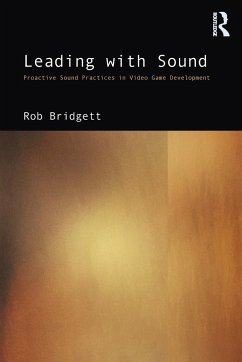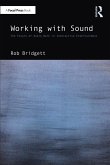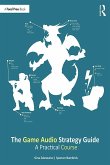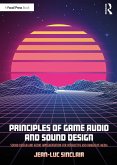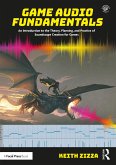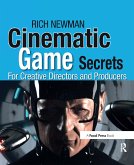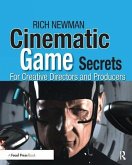- Broschiertes Buch
- Merkliste
- Auf die Merkliste
- Bewerten Bewerten
- Teilen
- Produkt teilen
- Produkterinnerung
- Produkterinnerung
Leading with Sound is the must-have companion guide to working on video game projects. Focused on the creative, collaborative, philosophical and organizational skills behind game sound and eschewing the technical, this book celebrates the subjects most essential to leading with sound in video game development at any level. Refuting the traditional optics of sound as a service in favour of sound as a pro-active visionary department, , this book examines each of the four food-groups of dialogue, sound design, music and mix, not through the usual technical and production lenses of 'how' and…mehr
Andere Kunden interessierten sich auch für
![Working with Sound Working with Sound]() Rob BridgettWorking with Sound36,99 €
Rob BridgettWorking with Sound36,99 €![The Game Audio Strategy Guide The Game Audio Strategy Guide]() Gina ZdanowiczThe Game Audio Strategy Guide79,99 €
Gina ZdanowiczThe Game Audio Strategy Guide79,99 €![Principles of Game Audio and Sound Design Principles of Game Audio and Sound Design]() Jean-Luc SinclairPrinciples of Game Audio and Sound Design41,99 €
Jean-Luc SinclairPrinciples of Game Audio and Sound Design41,99 €![Game Audio Fundamentals Game Audio Fundamentals]() Keith ZizzaGame Audio Fundamentals47,99 €
Keith ZizzaGame Audio Fundamentals47,99 €![Cinematic Game Secrets for Creative Directors and Producers Cinematic Game Secrets for Creative Directors and Producers]() Rich NewmanCinematic Game Secrets for Creative Directors and Producers48,99 €
Rich NewmanCinematic Game Secrets for Creative Directors and Producers48,99 €![Cinematic Game Secrets for Creative Directors and Producers Cinematic Game Secrets for Creative Directors and Producers]() Rich NewmanCinematic Game Secrets for Creative Directors and Producers163,99 €
Rich NewmanCinematic Game Secrets for Creative Directors and Producers163,99 €![Game Audio Mixing Game Audio Mixing]() Alex RiviereGame Audio Mixing36,99 €
Alex RiviereGame Audio Mixing36,99 €-
-
-
Leading with Sound is the must-have companion guide to working on video game projects. Focused on the creative, collaborative, philosophical and organizational skills behind game sound and eschewing the technical, this book celebrates the subjects most essential to leading with sound in video game development at any level. Refuting the traditional optics of sound as a service in favour of sound as a pro-active visionary department, , this book examines each of the four food-groups of dialogue, sound design, music and mix, not through the usual technical and production lenses of 'how' and 'when', but the essential lens of 'why' that enables leadership with sound.
Leading with Sound is essential reading for aspiring sound designers, inside and outside of the classroom, as well as experienced professionals in the game industry.
Leading with Sound is essential reading for aspiring sound designers, inside and outside of the classroom, as well as experienced professionals in the game industry.
Produktdetails
- Produktdetails
- Verlag: Focal Press / Taylor & Francis
- Seitenzahl: 236
- Erscheinungstermin: 19. Mai 2021
- Englisch
- Abmessung: 234mm x 156mm x 13mm
- Gewicht: 381g
- ISBN-13: 9780367535872
- ISBN-10: 0367535874
- Artikelnr.: 60799455
- Herstellerkennzeichnung
- Libri GmbH
- Europaallee 1
- 36244 Bad Hersfeld
- gpsr@libri.de
- Verlag: Focal Press / Taylor & Francis
- Seitenzahl: 236
- Erscheinungstermin: 19. Mai 2021
- Englisch
- Abmessung: 234mm x 156mm x 13mm
- Gewicht: 381g
- ISBN-13: 9780367535872
- ISBN-10: 0367535874
- Artikelnr.: 60799455
- Herstellerkennzeichnung
- Libri GmbH
- Europaallee 1
- 36244 Bad Hersfeld
- gpsr@libri.de
Rob Bridgett is a British-Canadian Audio Director based in Montreal. In 1993 Rob attended Derby University to study cinema and media, and was one of the first to graduate from the 'Sound Design for the Moving Image' Master's degree programme at Bournemouth University in 1999. Having worked as an audio director in the games industry since 2001, Bridgett has become a committed advocate for 'leading with sound' and 'sound as design'.
Part One: Ports of Entry
01 What is this Book About?
02 The Big Four: Understanding the Four Food-groups of Audio (and how they inter-relate)
03 What Drives the Mix of Your Game.
04 Taking a Psychological Approach to Sound Categorization
05 What is a Game Developer?
06 What is Game Audio?
07 What You May be Missing: Vision to Drive Your Tools and Pipelines
08 Communication Essentials: Managing Expectations of Quality (The 'L' Scale)
09 Developing Early Audio Visions
Part Two: Sound Design
10 Why do we Need Sounds?
11 Working with Sound.
12 Higher Level is Better.
13 What is Causing these Sounds and Where are they Located?
14 Ambiguity and Clarity.
15 Designing for Three Audiences. (Player, Spectator, Creator)
16 Thinking Horizontally, Vertically, and Diagonally about Asset Design.
17 Designing a Moment: Temporality in Interactive Sound Design.
18 Leading with Sound: Spectacle and Immersion.
Part Three: Music
19 Why do we Need Music?
20 Music as Creative Crutches: Reaching for Music Too Soon & Too Late.
21 Defining the Sound: Towards an Iconic Music Design
22 The Shape of Emotion: We Can't Feel Emotion All the Time.
23 Diegetic, Non-Diegetic and Trans-Diegetic Musical Spaces.
24 Non-Diegetic Space in Recorded Music
25 Leading with Music: Music as Spectacle Throughout Production and Post-Release
Part Four: Voice
26 Why do we Need Voice?
27 Early Dialogue Development
28 The Sound of Voice: Dialects, Culture and Meaning
29 Casting Philosophies (Auditions, Recording, Iteration)
30 Let's do it Again
31 Rethinking Dialogue Production: Infinite Alternatives
32 Leading with Voice: Leveraging the Spectacle of Performance
Part Five: Mix
33 Why do we Need to Mix?
34 Mix Essentials
35 Philosophy of the Mix: Narrative Dynamics (Pushing, Pulling, Shaping)
36 Some Defining Terminology and Features of Non-Linear Mixing
37 Mix Consistency
38 Building the Mix
39 Planning and Surviving the Major Milestone and Final Mixes.
40 Leading with the Mix: The First and Last Thing You Think About.
Part Six: Fade Out
41 The Importance of a Holistic (Four-Food-group) Vision
42 Studio Culture: A Theory of Everything
43 Game Audio Studio Spaces: Architectural Problems in Video Game Sound.
44 Games are for Everyone: Accessibility, Options and Customization in Audio for Gamers.
45 Finding Our Place, Between Vision and Service.
01 What is this Book About?
02 The Big Four: Understanding the Four Food-groups of Audio (and how they inter-relate)
03 What Drives the Mix of Your Game.
04 Taking a Psychological Approach to Sound Categorization
05 What is a Game Developer?
06 What is Game Audio?
07 What You May be Missing: Vision to Drive Your Tools and Pipelines
08 Communication Essentials: Managing Expectations of Quality (The 'L' Scale)
09 Developing Early Audio Visions
Part Two: Sound Design
10 Why do we Need Sounds?
11 Working with Sound.
12 Higher Level is Better.
13 What is Causing these Sounds and Where are they Located?
14 Ambiguity and Clarity.
15 Designing for Three Audiences. (Player, Spectator, Creator)
16 Thinking Horizontally, Vertically, and Diagonally about Asset Design.
17 Designing a Moment: Temporality in Interactive Sound Design.
18 Leading with Sound: Spectacle and Immersion.
Part Three: Music
19 Why do we Need Music?
20 Music as Creative Crutches: Reaching for Music Too Soon & Too Late.
21 Defining the Sound: Towards an Iconic Music Design
22 The Shape of Emotion: We Can't Feel Emotion All the Time.
23 Diegetic, Non-Diegetic and Trans-Diegetic Musical Spaces.
24 Non-Diegetic Space in Recorded Music
25 Leading with Music: Music as Spectacle Throughout Production and Post-Release
Part Four: Voice
26 Why do we Need Voice?
27 Early Dialogue Development
28 The Sound of Voice: Dialects, Culture and Meaning
29 Casting Philosophies (Auditions, Recording, Iteration)
30 Let's do it Again
31 Rethinking Dialogue Production: Infinite Alternatives
32 Leading with Voice: Leveraging the Spectacle of Performance
Part Five: Mix
33 Why do we Need to Mix?
34 Mix Essentials
35 Philosophy of the Mix: Narrative Dynamics (Pushing, Pulling, Shaping)
36 Some Defining Terminology and Features of Non-Linear Mixing
37 Mix Consistency
38 Building the Mix
39 Planning and Surviving the Major Milestone and Final Mixes.
40 Leading with the Mix: The First and Last Thing You Think About.
Part Six: Fade Out
41 The Importance of a Holistic (Four-Food-group) Vision
42 Studio Culture: A Theory of Everything
43 Game Audio Studio Spaces: Architectural Problems in Video Game Sound.
44 Games are for Everyone: Accessibility, Options and Customization in Audio for Gamers.
45 Finding Our Place, Between Vision and Service.
Part One: Ports of Entry
01 What is this Book About?
02 The Big Four: Understanding the Four Food-groups of Audio (and how they
inter-relate)
03 What Drives the Mix of Your Game.
04 Taking a Psychological Approach to Sound Categorization
05 What is a Game Developer?
06 What is Game Audio?
07 What You May be Missing: Vision to Drive Your Tools and Pipelines
08 Communication Essentials: Managing Expectations of Quality (The 'L'
Scale)
09 Developing Early Audio Visions
Part Two: Sound Design
10 Why do we Need Sounds?
11 Working with Sound.
12 Higher Level is Better.
13 What is Causing these Sounds and Where are they Located?
14 Ambiguity and Clarity.
15 Designing for Three Audiences. (Player, Spectator, Creator)
16 Thinking Horizontally, Vertically, and Diagonally about Asset Design.
17 Designing a Moment: Temporality in Interactive Sound Design.
18 Leading with Sound: Spectacle and Immersion.
Part Three: Music
19 Why do we Need Music?
20 Music as Creative Crutches: Reaching for Music Too Soon & Too Late.
21 Defining the Sound: Towards an Iconic Music Design
22 The Shape of Emotion: We Can't Feel Emotion All the Time.
23 Diegetic, Non-Diegetic and Trans-Diegetic Musical Spaces.
24 Non-Diegetic Space in Recorded Music
25 Leading with Music: Music as Spectacle Throughout Production and
Post-Release
Part Four: Voice
26 Why do we Need Voice?
27 Early Dialogue Development
28 The Sound of Voice: Dialects, Culture and Meaning
29 Casting Philosophies (Auditions, Recording, Iteration)
30 Let's do it Again
31 Rethinking Dialogue Production: Infinite Alternatives
32 Leading with Voice: Leveraging the Spectacle of Performance
Part Five: Mix
33 Why do we Need to Mix?
34 Mix Essentials
35 Philosophy of the Mix: Narrative Dynamics (Pushing, Pulling, Shaping)
36 Some Defining Terminology and Features of Non-Linear Mixing
37 Mix Consistency
38 Building the Mix
39 Planning and Surviving the Major Milestone and Final Mixes.
40 Leading with the Mix: The First and Last Thing You Think About.
Part Six: Fade Out
41 The Importance of a Holistic (Four-Food-group) Vision
42 Studio Culture: A Theory of Everything
43 Game Audio Studio Spaces: Architectural Problems in Video Game Sound.
44 Games are for Everyone: Accessibility, Options and Customization in
Audio for Gamers.
45 Finding Our Place, Between Vision and Service.
01 What is this Book About?
02 The Big Four: Understanding the Four Food-groups of Audio (and how they
inter-relate)
03 What Drives the Mix of Your Game.
04 Taking a Psychological Approach to Sound Categorization
05 What is a Game Developer?
06 What is Game Audio?
07 What You May be Missing: Vision to Drive Your Tools and Pipelines
08 Communication Essentials: Managing Expectations of Quality (The 'L'
Scale)
09 Developing Early Audio Visions
Part Two: Sound Design
10 Why do we Need Sounds?
11 Working with Sound.
12 Higher Level is Better.
13 What is Causing these Sounds and Where are they Located?
14 Ambiguity and Clarity.
15 Designing for Three Audiences. (Player, Spectator, Creator)
16 Thinking Horizontally, Vertically, and Diagonally about Asset Design.
17 Designing a Moment: Temporality in Interactive Sound Design.
18 Leading with Sound: Spectacle and Immersion.
Part Three: Music
19 Why do we Need Music?
20 Music as Creative Crutches: Reaching for Music Too Soon & Too Late.
21 Defining the Sound: Towards an Iconic Music Design
22 The Shape of Emotion: We Can't Feel Emotion All the Time.
23 Diegetic, Non-Diegetic and Trans-Diegetic Musical Spaces.
24 Non-Diegetic Space in Recorded Music
25 Leading with Music: Music as Spectacle Throughout Production and
Post-Release
Part Four: Voice
26 Why do we Need Voice?
27 Early Dialogue Development
28 The Sound of Voice: Dialects, Culture and Meaning
29 Casting Philosophies (Auditions, Recording, Iteration)
30 Let's do it Again
31 Rethinking Dialogue Production: Infinite Alternatives
32 Leading with Voice: Leveraging the Spectacle of Performance
Part Five: Mix
33 Why do we Need to Mix?
34 Mix Essentials
35 Philosophy of the Mix: Narrative Dynamics (Pushing, Pulling, Shaping)
36 Some Defining Terminology and Features of Non-Linear Mixing
37 Mix Consistency
38 Building the Mix
39 Planning and Surviving the Major Milestone and Final Mixes.
40 Leading with the Mix: The First and Last Thing You Think About.
Part Six: Fade Out
41 The Importance of a Holistic (Four-Food-group) Vision
42 Studio Culture: A Theory of Everything
43 Game Audio Studio Spaces: Architectural Problems in Video Game Sound.
44 Games are for Everyone: Accessibility, Options and Customization in
Audio for Gamers.
45 Finding Our Place, Between Vision and Service.
Part One: Ports of Entry
01 What is this Book About?
02 The Big Four: Understanding the Four Food-groups of Audio (and how they inter-relate)
03 What Drives the Mix of Your Game.
04 Taking a Psychological Approach to Sound Categorization
05 What is a Game Developer?
06 What is Game Audio?
07 What You May be Missing: Vision to Drive Your Tools and Pipelines
08 Communication Essentials: Managing Expectations of Quality (The 'L' Scale)
09 Developing Early Audio Visions
Part Two: Sound Design
10 Why do we Need Sounds?
11 Working with Sound.
12 Higher Level is Better.
13 What is Causing these Sounds and Where are they Located?
14 Ambiguity and Clarity.
15 Designing for Three Audiences. (Player, Spectator, Creator)
16 Thinking Horizontally, Vertically, and Diagonally about Asset Design.
17 Designing a Moment: Temporality in Interactive Sound Design.
18 Leading with Sound: Spectacle and Immersion.
Part Three: Music
19 Why do we Need Music?
20 Music as Creative Crutches: Reaching for Music Too Soon & Too Late.
21 Defining the Sound: Towards an Iconic Music Design
22 The Shape of Emotion: We Can't Feel Emotion All the Time.
23 Diegetic, Non-Diegetic and Trans-Diegetic Musical Spaces.
24 Non-Diegetic Space in Recorded Music
25 Leading with Music: Music as Spectacle Throughout Production and Post-Release
Part Four: Voice
26 Why do we Need Voice?
27 Early Dialogue Development
28 The Sound of Voice: Dialects, Culture and Meaning
29 Casting Philosophies (Auditions, Recording, Iteration)
30 Let's do it Again
31 Rethinking Dialogue Production: Infinite Alternatives
32 Leading with Voice: Leveraging the Spectacle of Performance
Part Five: Mix
33 Why do we Need to Mix?
34 Mix Essentials
35 Philosophy of the Mix: Narrative Dynamics (Pushing, Pulling, Shaping)
36 Some Defining Terminology and Features of Non-Linear Mixing
37 Mix Consistency
38 Building the Mix
39 Planning and Surviving the Major Milestone and Final Mixes.
40 Leading with the Mix: The First and Last Thing You Think About.
Part Six: Fade Out
41 The Importance of a Holistic (Four-Food-group) Vision
42 Studio Culture: A Theory of Everything
43 Game Audio Studio Spaces: Architectural Problems in Video Game Sound.
44 Games are for Everyone: Accessibility, Options and Customization in Audio for Gamers.
45 Finding Our Place, Between Vision and Service.
01 What is this Book About?
02 The Big Four: Understanding the Four Food-groups of Audio (and how they inter-relate)
03 What Drives the Mix of Your Game.
04 Taking a Psychological Approach to Sound Categorization
05 What is a Game Developer?
06 What is Game Audio?
07 What You May be Missing: Vision to Drive Your Tools and Pipelines
08 Communication Essentials: Managing Expectations of Quality (The 'L' Scale)
09 Developing Early Audio Visions
Part Two: Sound Design
10 Why do we Need Sounds?
11 Working with Sound.
12 Higher Level is Better.
13 What is Causing these Sounds and Where are they Located?
14 Ambiguity and Clarity.
15 Designing for Three Audiences. (Player, Spectator, Creator)
16 Thinking Horizontally, Vertically, and Diagonally about Asset Design.
17 Designing a Moment: Temporality in Interactive Sound Design.
18 Leading with Sound: Spectacle and Immersion.
Part Three: Music
19 Why do we Need Music?
20 Music as Creative Crutches: Reaching for Music Too Soon & Too Late.
21 Defining the Sound: Towards an Iconic Music Design
22 The Shape of Emotion: We Can't Feel Emotion All the Time.
23 Diegetic, Non-Diegetic and Trans-Diegetic Musical Spaces.
24 Non-Diegetic Space in Recorded Music
25 Leading with Music: Music as Spectacle Throughout Production and Post-Release
Part Four: Voice
26 Why do we Need Voice?
27 Early Dialogue Development
28 The Sound of Voice: Dialects, Culture and Meaning
29 Casting Philosophies (Auditions, Recording, Iteration)
30 Let's do it Again
31 Rethinking Dialogue Production: Infinite Alternatives
32 Leading with Voice: Leveraging the Spectacle of Performance
Part Five: Mix
33 Why do we Need to Mix?
34 Mix Essentials
35 Philosophy of the Mix: Narrative Dynamics (Pushing, Pulling, Shaping)
36 Some Defining Terminology and Features of Non-Linear Mixing
37 Mix Consistency
38 Building the Mix
39 Planning and Surviving the Major Milestone and Final Mixes.
40 Leading with the Mix: The First and Last Thing You Think About.
Part Six: Fade Out
41 The Importance of a Holistic (Four-Food-group) Vision
42 Studio Culture: A Theory of Everything
43 Game Audio Studio Spaces: Architectural Problems in Video Game Sound.
44 Games are for Everyone: Accessibility, Options and Customization in Audio for Gamers.
45 Finding Our Place, Between Vision and Service.
Part One: Ports of Entry
01 What is this Book About?
02 The Big Four: Understanding the Four Food-groups of Audio (and how they
inter-relate)
03 What Drives the Mix of Your Game.
04 Taking a Psychological Approach to Sound Categorization
05 What is a Game Developer?
06 What is Game Audio?
07 What You May be Missing: Vision to Drive Your Tools and Pipelines
08 Communication Essentials: Managing Expectations of Quality (The 'L'
Scale)
09 Developing Early Audio Visions
Part Two: Sound Design
10 Why do we Need Sounds?
11 Working with Sound.
12 Higher Level is Better.
13 What is Causing these Sounds and Where are they Located?
14 Ambiguity and Clarity.
15 Designing for Three Audiences. (Player, Spectator, Creator)
16 Thinking Horizontally, Vertically, and Diagonally about Asset Design.
17 Designing a Moment: Temporality in Interactive Sound Design.
18 Leading with Sound: Spectacle and Immersion.
Part Three: Music
19 Why do we Need Music?
20 Music as Creative Crutches: Reaching for Music Too Soon & Too Late.
21 Defining the Sound: Towards an Iconic Music Design
22 The Shape of Emotion: We Can't Feel Emotion All the Time.
23 Diegetic, Non-Diegetic and Trans-Diegetic Musical Spaces.
24 Non-Diegetic Space in Recorded Music
25 Leading with Music: Music as Spectacle Throughout Production and
Post-Release
Part Four: Voice
26 Why do we Need Voice?
27 Early Dialogue Development
28 The Sound of Voice: Dialects, Culture and Meaning
29 Casting Philosophies (Auditions, Recording, Iteration)
30 Let's do it Again
31 Rethinking Dialogue Production: Infinite Alternatives
32 Leading with Voice: Leveraging the Spectacle of Performance
Part Five: Mix
33 Why do we Need to Mix?
34 Mix Essentials
35 Philosophy of the Mix: Narrative Dynamics (Pushing, Pulling, Shaping)
36 Some Defining Terminology and Features of Non-Linear Mixing
37 Mix Consistency
38 Building the Mix
39 Planning and Surviving the Major Milestone and Final Mixes.
40 Leading with the Mix: The First and Last Thing You Think About.
Part Six: Fade Out
41 The Importance of a Holistic (Four-Food-group) Vision
42 Studio Culture: A Theory of Everything
43 Game Audio Studio Spaces: Architectural Problems in Video Game Sound.
44 Games are for Everyone: Accessibility, Options and Customization in
Audio for Gamers.
45 Finding Our Place, Between Vision and Service.
01 What is this Book About?
02 The Big Four: Understanding the Four Food-groups of Audio (and how they
inter-relate)
03 What Drives the Mix of Your Game.
04 Taking a Psychological Approach to Sound Categorization
05 What is a Game Developer?
06 What is Game Audio?
07 What You May be Missing: Vision to Drive Your Tools and Pipelines
08 Communication Essentials: Managing Expectations of Quality (The 'L'
Scale)
09 Developing Early Audio Visions
Part Two: Sound Design
10 Why do we Need Sounds?
11 Working with Sound.
12 Higher Level is Better.
13 What is Causing these Sounds and Where are they Located?
14 Ambiguity and Clarity.
15 Designing for Three Audiences. (Player, Spectator, Creator)
16 Thinking Horizontally, Vertically, and Diagonally about Asset Design.
17 Designing a Moment: Temporality in Interactive Sound Design.
18 Leading with Sound: Spectacle and Immersion.
Part Three: Music
19 Why do we Need Music?
20 Music as Creative Crutches: Reaching for Music Too Soon & Too Late.
21 Defining the Sound: Towards an Iconic Music Design
22 The Shape of Emotion: We Can't Feel Emotion All the Time.
23 Diegetic, Non-Diegetic and Trans-Diegetic Musical Spaces.
24 Non-Diegetic Space in Recorded Music
25 Leading with Music: Music as Spectacle Throughout Production and
Post-Release
Part Four: Voice
26 Why do we Need Voice?
27 Early Dialogue Development
28 The Sound of Voice: Dialects, Culture and Meaning
29 Casting Philosophies (Auditions, Recording, Iteration)
30 Let's do it Again
31 Rethinking Dialogue Production: Infinite Alternatives
32 Leading with Voice: Leveraging the Spectacle of Performance
Part Five: Mix
33 Why do we Need to Mix?
34 Mix Essentials
35 Philosophy of the Mix: Narrative Dynamics (Pushing, Pulling, Shaping)
36 Some Defining Terminology and Features of Non-Linear Mixing
37 Mix Consistency
38 Building the Mix
39 Planning and Surviving the Major Milestone and Final Mixes.
40 Leading with the Mix: The First and Last Thing You Think About.
Part Six: Fade Out
41 The Importance of a Holistic (Four-Food-group) Vision
42 Studio Culture: A Theory of Everything
43 Game Audio Studio Spaces: Architectural Problems in Video Game Sound.
44 Games are for Everyone: Accessibility, Options and Customization in
Audio for Gamers.
45 Finding Our Place, Between Vision and Service.

